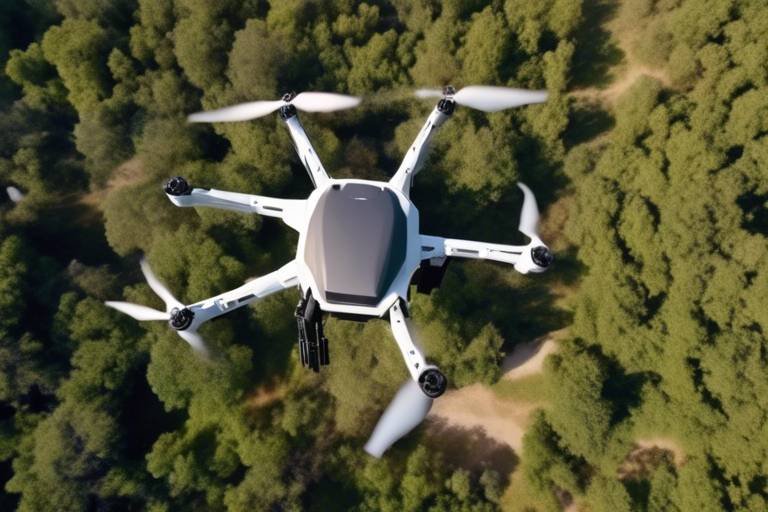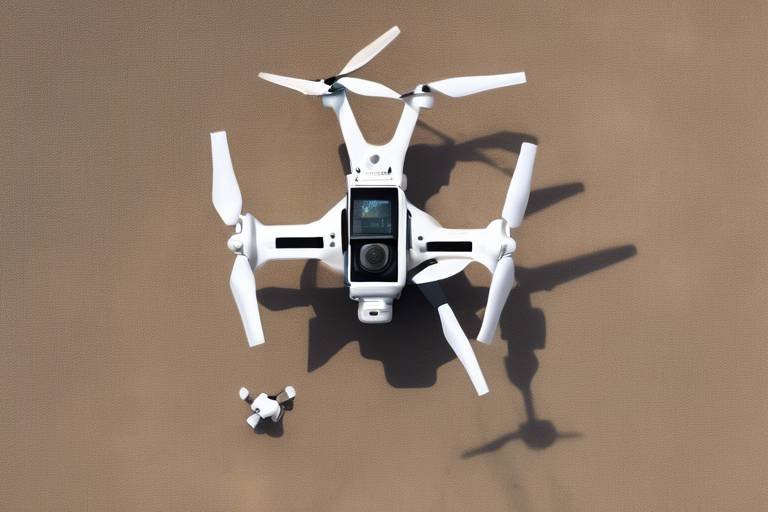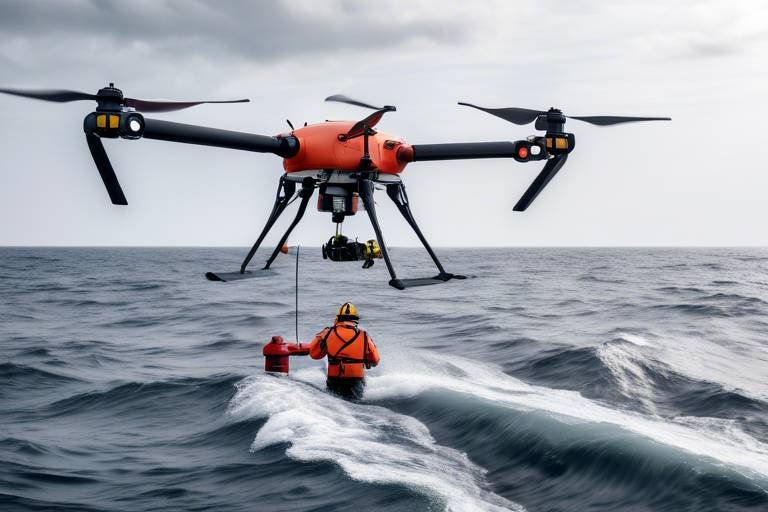The Use of Unmanned Systems in Enhancing Climate Resilience of Cities
In an age where climate change is no longer a distant threat but a pressing reality, cities around the globe are scrambling to adapt. The challenge is monumental—how do we fortify urban environments against the relentless forces of nature? Enter unmanned systems, a game-changer in the quest for urban climate resilience. These innovative technologies, including drones and autonomous vehicles, are not just futuristic gadgets; they are powerful tools that can significantly enhance our ability to monitor, respond to, and recover from climate-related challenges.
Imagine a city where drones soar above, capturing real-time data on air quality, temperature fluctuations, and even potential flood zones. Picture autonomous vehicles delivering essential supplies to areas cut off by disaster, or deploying sensors that provide instant feedback on environmental changes. This is not a scene from a sci-fi movie; it is the potential reality that unmanned systems offer. By integrating these technologies into urban management, cities can develop more effective resilience strategies that are proactive rather than reactive.
As we delve deeper into this topic, it becomes clear that unmanned systems are not merely supplementary; they are essential in crafting a sustainable urban future. Whether it's through enhancing disaster response capabilities or optimizing infrastructure management, these technologies are paving the way for smarter, more resilient cities. Let's explore how these unmanned systems are reshaping our urban landscapes and contributing to climate resilience.
Unmanned systems encompass a range of technologies, including drones and autonomous ground vehicles, that operate without human intervention. Their capabilities are revolutionizing various sectors, particularly in urban management and climate resilience. Drones can capture high-resolution images, monitor environmental conditions, and even deliver supplies in emergencies. Meanwhile, autonomous vehicles can traverse difficult terrains, making them invaluable in disaster-stricken areas. The versatility of these systems allows cities to address climate challenges from multiple angles, enhancing overall resilience.
Cities are increasingly vulnerable to climate change, facing threats like flooding, heatwaves, and extreme weather events. Understanding these impacts is crucial for developing effective resilience strategies and leveraging technology for urban safety. For instance, rising sea levels can inundate coastal cities, while urban heat islands exacerbate temperature extremes. By utilizing unmanned systems, cities can gather critical data to assess their vulnerabilities and prioritize interventions. This proactive approach not only saves lives but also mitigates economic losses associated with climate-induced disasters.
Unmanned systems excel in data collection, providing real-time monitoring of environmental conditions. This capability is essential for cities to assess vulnerabilities, track changes, and implement timely interventions to mitigate climate risks. For example, drones equipped with sensors can monitor air quality and detect pollution hotspots, allowing city planners to address health hazards promptly. Furthermore, autonomous vehicles can gather spatial data that informs urban planning decisions, ensuring that resources are allocated efficiently. The ability to collect and analyze data in real-time empowers cities to stay ahead of climate challenges.
In the event of climate-related disasters, unmanned systems can facilitate rapid response efforts. Their ability to access hard-to-reach areas and deliver supplies enhances recovery operations and supports affected communities during crises. Imagine a drone delivering medical supplies to a flooded neighborhood or an autonomous vehicle transporting food and water to those stranded by a storm. These systems can significantly reduce response times, saving lives and enabling communities to recover more swiftly. Moreover, the data collected during these operations can inform future preparedness strategies, creating a cycle of continuous improvement.
Integrating unmanned systems into urban planning can optimize infrastructure management. By analyzing spatial data, cities can make informed decisions on resource allocation, land use, and climate adaptation strategies to enhance resilience. For instance, drones can survey infrastructure conditions, identifying areas in need of repair before they become critical failures. This proactive maintenance approach not only extends the lifespan of urban assets but also ensures that cities are better equipped to handle climate impacts.
Engaging communities in climate resilience efforts is vital. Unmanned systems can facilitate educational initiatives, showcasing their applications in monitoring and response, and empowering citizens to participate in resilience-building activities. Workshops and demonstrations using drones can illustrate how these technologies work in real-time, fostering a sense of ownership and responsibility among residents. When communities understand the tools at their disposal, they are more likely to engage in proactive measures that enhance overall resilience.
The deployment of unmanned systems in urban environments raises important policy and regulatory questions. Establishing guidelines ensures safe and effective use while addressing privacy, security, and ethical concerns related to technology. Cities must navigate the delicate balance between leveraging innovation and protecting citizen rights. Crafting comprehensive policies that govern the use of unmanned systems will be crucial in maximizing their benefits while minimizing potential risks.
The future of unmanned systems in enhancing climate resilience is promising, with ongoing innovations in technology and applications. Exploring emerging trends will reveal new opportunities for cities to adapt and thrive amidst climate challenges. From advancements in AI that improve data analysis to the development of more sustainable drone technologies, the horizon is bright. Cities that embrace these innovations will not only enhance their resilience but also set a precedent for others to follow.
- What are unmanned systems? Unmanned systems refer to technologies like drones and autonomous vehicles that operate without human intervention, providing valuable data and support in various sectors.
- How do unmanned systems help in disaster response? They can quickly access hard-to-reach areas, deliver supplies, and gather critical data to aid recovery efforts during climate-related disasters.
- What role do unmanned systems play in urban planning? They assist in optimizing infrastructure management and resource allocation by providing real-time data analysis and monitoring capabilities.
- Are there any privacy concerns with using unmanned systems? Yes, the deployment of these technologies raises important privacy and security questions that need to be addressed through comprehensive policies and regulations.
Understanding Unmanned Systems
Unmanned systems are transforming the way we interact with our environments, particularly in urban settings where the challenges of climate change loom large. These technologies, which include drones, autonomous ground vehicles, and even unmanned underwater vehicles, operate without the need for direct human control. Imagine a world where machines can perform tasks that once required human presence; this is not science fiction but a reality that is reshaping urban management and climate resilience strategies.
At the heart of unmanned systems is the ability to collect and process vast amounts of data. For example, drones equipped with advanced sensors can fly over urban landscapes, capturing high-resolution images and environmental data. This information is invaluable for city planners and emergency responders alike. It allows them to monitor changes in land use, assess the health of urban ecosystems, and even track the progress of climate-related impacts. In essence, unmanned systems serve as the eyes and ears of our cities, providing crucial insights that help us make informed decisions.
Moreover, the versatility of unmanned systems is one of their greatest strengths. They can be deployed in various scenarios, whether it's surveying flood-prone areas, inspecting infrastructure, or delivering supplies during a disaster. The operational scope of these systems is vast, and their ability to access hard-to-reach locations makes them indispensable in times of crisis. For instance, during a flood, drones can quickly assess damage and identify areas in need of immediate assistance, all while keeping human responders safe from hazardous conditions.
As we delve deeper into the world of unmanned systems, it’s essential to recognize the different types available. Here’s a brief overview:
- Drones: These aerial vehicles are often used for surveillance, mapping, and environmental monitoring.
- Autonomous Ground Vehicles: These include self-driving cars and robotic systems that can navigate urban landscapes to perform various tasks.
- Unmanned Underwater Vehicles: While less common in urban settings, these can be crucial for monitoring water quality and underwater ecosystems.
The integration of unmanned systems into urban planning and climate resilience strategies is not just about technology; it's about enhancing the quality of life for city dwellers. With their ability to provide real-time data and facilitate rapid response, these systems can help cities become more adaptive and resilient in the face of climate challenges. As we continue to explore their potential, it's clear that unmanned systems are not just tools; they are pivotal players in the quest for sustainable urban living.
Climate Change Impacts on Urban Areas
As we stand on the precipice of a climate crisis, it's becoming increasingly clear that cities are on the front lines of this battle. Urban areas, bustling with life and activity, are particularly vulnerable to the impacts of climate change. From rising temperatures to extreme weather events, the challenges cities face are numerous and complex. Have you ever thought about how a simple heatwave could disrupt an entire city's daily routine? Or how a sudden flood could turn a thriving neighborhood into a disaster zone? These scenarios are becoming more common, and understanding their implications is crucial for developing effective resilience strategies.
The impacts of climate change on urban areas can be categorized into several major threats:
- Flooding: Increased rainfall and rising sea levels lead to more frequent and severe flooding. Cities with inadequate drainage systems are particularly at risk, as water can quickly accumulate, causing chaos and destruction.
- Heatwaves: Urban heat islands, where city areas become significantly warmer than their rural surroundings, exacerbate the effects of heatwaves. This can lead to health risks, especially for vulnerable populations.
- Extreme Weather Events: Hurricanes, storms, and wildfires are becoming more intense and unpredictable. These events not only damage infrastructure but also displace communities and disrupt essential services.
Beyond these immediate threats, climate change also has long-term implications for urban planning and infrastructure. For instance, the increased frequency of natural disasters forces cities to reconsider their infrastructure resilience. Buildings, roads, and public transport systems must be designed to withstand not just the current climate, but also the future climate scenarios that scientists are predicting. This requires a paradigm shift in how we think about urban development.
Moreover, the socio-economic effects of climate change cannot be overlooked. Vulnerable communities, often located in high-risk areas, bear the brunt of these changes. They may lack the resources to adapt or recover, leading to a cycle of poverty and displacement. It’s a sobering thought: as the climate continues to change, the gap between those who can cope and those who cannot will only widen. Thus, addressing these disparities is not just a matter of equity; it’s essential for the overall resilience of our cities.
In summary, the impacts of climate change on urban areas are profound and multifaceted. Cities must not only recognize these threats but also actively engage in developing strategies that enhance resilience. This involves leveraging technology, like unmanned systems, to monitor, respond to, and recover from climate-related challenges effectively. The road ahead may be fraught with obstacles, but with the right tools and mindset, urban areas can adapt and thrive in the face of adversity.
Q: How does climate change specifically affect urban areas?
A: Climate change impacts urban areas through increased flooding, heatwaves, and extreme weather events, which can disrupt daily life and threaten infrastructure.
Q: What role do unmanned systems play in urban climate resilience?
A: Unmanned systems, such as drones and autonomous vehicles, enhance urban resilience by improving data collection, monitoring environmental conditions, and facilitating rapid disaster response.
Q: Why is community engagement important in climate resilience efforts?
A: Engaging communities helps raise awareness, fosters participation in resilience-building activities, and empowers citizens to contribute to local climate adaptation strategies.
Data Collection and Monitoring
In the age of technology, have become pivotal in tackling climate change challenges faced by urban areas. Unmanned systems, particularly drones and autonomous vehicles, are at the forefront of this revolution. Imagine a bird's-eye view of your city, capturing real-time data on everything from air quality to temperature fluctuations. These systems are not just tools; they are the eyes and ears of our urban environments, providing critical insights that were once difficult to obtain.
One of the standout features of unmanned systems is their ability to gather data across vast areas quickly and efficiently. For instance, drones can fly over neighborhoods, surveying damage after a storm or mapping out areas prone to flooding. This capability is invaluable for city planners and emergency responders. By harnessing this data, they can identify vulnerable zones and make informed decisions on how to allocate resources effectively. The speed and accuracy of data collection can mean the difference between a swift recovery and prolonged disruption for affected communities.
Moreover, these unmanned systems can operate in environments that are hazardous for humans. Think about the aftermath of a natural disaster: debris, unstable structures, and hazardous materials can pose significant risks. Drones can safely navigate through these challenging conditions, collecting data that helps assess the situation without putting human lives at risk. This capability not only enhances safety but also accelerates the recovery process.
Real-time monitoring is another critical aspect where unmanned systems shine. Equipped with advanced sensors, drones can continuously track environmental conditions, such as temperature changes, air quality, and even vegetation health. This ongoing data stream allows cities to respond proactively to emerging threats. For example, if a drone detects rising temperatures in a specific area, city planners can implement cooling strategies, such as opening public cooling centers or increasing shade through tree planting initiatives.
To illustrate the impact of data collection and monitoring, consider the following table that highlights the various applications of unmanned systems in urban environments:
| Application | Description | Benefits |
|---|---|---|
| Disaster Assessment | Using drones for post-disaster surveys | Faster recovery, safer assessments |
| Environmental Monitoring | Tracking air and water quality | Informed public health decisions |
| Urban Heat Mapping | Identifying heat islands in cities | Targeted cooling strategies |
| Infrastructure Inspection | Monitoring bridges, roads, and buildings | Preventative maintenance, enhanced safety |
As cities strive to become more resilient, the integration of unmanned systems into data collection and monitoring processes is not just beneficial; it's essential. By leveraging these advanced technologies, urban areas can not only respond to climate-related challenges but also anticipate them. The future of our cities depends on how well we can harness the power of data to create safer, more sustainable environments for all.
Q: How do unmanned systems improve data accuracy?
A: Unmanned systems utilize advanced sensors and technology to collect data in real-time, reducing human error and providing precise measurements across various environmental factors.
Q: Can drones be used for long-term monitoring?
A: Yes, drones can be deployed for extended periods to continuously monitor environmental changes, allowing cities to track trends over time and adjust their strategies accordingly.
Q: What are the limitations of using unmanned systems for data collection?
A: While unmanned systems are highly effective, they may face challenges such as regulatory restrictions, the need for skilled operators, and potential technical malfunctions.
Disaster Response and Recovery
When disaster strikes, the clock starts ticking, and every second counts. In the chaotic aftermath of climate-related events, such as hurricanes or wildfires, the ability to respond swiftly can mean the difference between life and death. This is where unmanned systems come into play, acting as the unsung heroes of disaster response and recovery. Picture this: a drone soaring above a devastated landscape, providing critical real-time data to emergency responders. It’s like having a bird’s eye view of the situation, which is invaluable when assessing damage and planning recovery efforts.
Unmanned systems, particularly drones, have the remarkable ability to access hard-to-reach areas that might be too dangerous or inaccessible for human responders. For instance, after a major flood, traditional rescue teams may struggle to navigate submerged roads. However, drones can easily fly over these obstacles, delivering crucial supplies like food, water, and medical kits to stranded individuals. The agility of these systems allows for a rapid deployment of resources, ensuring that help reaches those in need as quickly as possible.
Moreover, the use of unmanned systems enhances communication among various agencies involved in disaster response. By collecting and transmitting data in real-time, drones can help coordinate efforts between local authorities, non-profits, and federal agencies. This level of collaboration is essential in managing resources effectively and avoiding duplication of efforts. For example, a drone might identify areas where aid has already been delivered, allowing teams to focus on regions that still require assistance.
In addition to immediate response, unmanned systems play a crucial role in the recovery phase. They can be employed to conduct aerial assessments of the damage, helping urban planners and disaster recovery teams to evaluate the extent of destruction. This information is vital for developing a comprehensive recovery plan. By analyzing the data collected, cities can prioritize rebuilding efforts, allocate funds efficiently, and implement strategies that address vulnerabilities exposed by the disaster.
Furthermore, the integration of unmanned systems into recovery operations can foster community resilience. By engaging local residents in recovery efforts, cities can empower citizens to take an active role in rebuilding their neighborhoods. Drones can be used to document the recovery process, showcasing the progress made and highlighting areas that still need attention. This transparency not only builds trust within the community but also encourages greater participation in future resilience initiatives.
It’s important to note that while unmanned systems offer significant advantages in disaster response and recovery, their deployment must be done thoughtfully. Issues such as privacy concerns, airspace regulations, and the ethical implications of surveillance need to be addressed. Establishing clear guidelines and frameworks for the use of these technologies will ensure that they are utilized safely and effectively, maximizing their potential to save lives and enhance community resilience.
- What types of unmanned systems are commonly used in disaster response?
Common types include drones for aerial surveillance and delivery, as well as autonomous ground vehicles for transporting supplies in difficult terrains.
- How do unmanned systems improve communication during disasters?
They provide real-time data and imagery, allowing different agencies to coordinate efforts and streamline rescue operations.
- What are the privacy concerns associated with using drones in disaster areas?
Drones may inadvertently capture footage of individuals without consent, raising ethical questions about surveillance and data usage.
- Can unmanned systems be used for long-term recovery efforts?
Yes, they can assist in damage assessments, monitoring recovery progress, and engaging communities in rebuilding efforts.
Urban Planning and Infrastructure Management
Urban planning is like the blueprint of a city; it shapes the way we live, work, and interact with our surroundings. With the looming challenges of climate change, cities must adopt innovative strategies to enhance their resilience. Unmanned systems, particularly drones and autonomous vehicles, are transforming the landscape of urban planning and infrastructure management. These technologies enable city planners to gather critical data, analyze environmental conditions, and make informed decisions that can significantly improve urban resilience.
Imagine a city where planners can visualize real-time data on air quality, temperature fluctuations, and even traffic patterns. This is not a distant dream; it’s a reality made possible by unmanned systems. By leveraging geospatial data collected from drones, cities can pinpoint areas that are most vulnerable to climate impacts. For instance, during a heatwave, planners can identify neighborhoods that may require additional green spaces or shaded areas to mitigate heat effects. This proactive approach ensures that cities are not just reacting to climate challenges but are actively preparing for them.
Furthermore, unmanned systems facilitate comprehensive infrastructure assessments. Traditional methods of inspecting bridges, roads, and buildings can be time-consuming and hazardous. Drones can swiftly survey these structures, providing high-resolution images and data that help identify maintenance needs before they escalate into major issues. This not only saves time and resources but also enhances public safety. Imagine a drone flying over a bridge, capturing detailed images that reveal cracks or structural weaknesses that might go unnoticed by human inspectors. This capability is invaluable in prioritizing repairs and ensuring that infrastructure remains robust against climate-induced stresses.
Moreover, the integration of unmanned systems into urban planning extends to resource allocation. Cities can utilize data analytics to optimize the distribution of resources, ensuring that areas most affected by climate change receive the necessary support. For example, if a particular district is prone to flooding, planners can allocate funds for improved drainage systems or flood barriers based on data collected by drones. This targeted approach not only enhances efficiency but also maximizes the impact of investments in urban resilience.
As we look to the future, the role of unmanned systems in urban planning will only grow. With advancements in artificial intelligence and machine learning, these systems will become even more adept at predicting climate impacts and suggesting adaptive measures. Cities will be able to simulate various scenarios, allowing planners to visualize the potential outcomes of different strategies. This level of foresight is crucial in a world where climate change is a constant threat.
In conclusion, integrating unmanned systems into urban planning and infrastructure management is not just a trend; it’s a necessity for cities aiming to thrive in the face of climate change. By harnessing the power of technology, cities can create resilient environments that protect their inhabitants and adapt to future challenges. The synergy between technology and urban planning is a game-changer, paving the way for smarter, more sustainable cities.
- What are unmanned systems? Unmanned systems refer to technologies like drones and autonomous vehicles that operate without human intervention, often used for data collection and monitoring.
- How do drones help in urban planning? Drones provide real-time data on environmental conditions, enabling planners to make informed decisions regarding resource allocation and infrastructure management.
- What are the benefits of using unmanned systems for infrastructure management? They allow for rapid assessments of structures, enhancing public safety and reducing maintenance costs by identifying issues before they become critical.
- Can unmanned systems predict climate impacts? Yes, with advancements in AI and machine learning, unmanned systems can analyze data to predict potential climate impacts and suggest adaptive measures.
Community Engagement and Education
In the face of climate change, community engagement is not just a buzzword; it's a necessity. When it comes to enhancing urban climate resilience, involving the community can lead to more effective and sustainable solutions. Unmanned systems, such as drones and autonomous vehicles, can play a pivotal role in this process. Imagine a drone flying over your neighborhood, collecting data on air quality or monitoring local wildlife. This technology can serve as a bridge between the scientific community and the public, making complex data accessible and understandable.
One of the most exciting aspects of unmanned systems is their ability to facilitate educational initiatives. By showcasing their applications in real-time monitoring and disaster response, these technologies can empower citizens to take an active role in resilience-building activities. For instance, local schools can collaborate with city planners to use drones for environmental science projects, turning students into budding environmental stewards. This hands-on experience not only educates but also fosters a sense of responsibility and connection to the community.
Moreover, workshops and community events can be organized where residents can learn about the capabilities of unmanned systems. These gatherings can be interactive, allowing community members to operate drones or engage in simulations of disaster response scenarios. By demystifying the technology, we can eliminate fears and misconceptions, encouraging more people to participate in climate resilience efforts. Just think about it: when people understand how these systems work, they are more likely to support their use and advocate for their integration into city planning.
In addition to education, community engagement can take various forms, such as:
- Public forums: Where citizens can voice concerns and share ideas about climate resilience strategies.
- Collaborative projects: Involving local organizations and residents in data collection and analysis.
- Social media campaigns: To raise awareness about climate issues and the role of technology in addressing them.
Ultimately, the goal is to create a culture of resilience where community members feel informed and empowered. By leveraging unmanned systems for education and engagement, cities can foster a collaborative environment where everyone plays a role in combating climate change. This approach not only enhances urban resilience but also strengthens community bonds, making cities more vibrant and adaptive to future challenges.
| Question | Answer |
|---|---|
| How can unmanned systems help in community education? | Unmanned systems can provide hands-on learning experiences, allowing community members to interact with technology and understand its applications in climate resilience. |
| What role do community forums play in climate resilience? | Community forums allow residents to express their concerns and ideas, fostering collaboration between citizens and local authorities. |
| Why is community engagement important for climate resilience? | Engaged communities are more likely to support and participate in resilience initiatives, leading to more effective and sustainable solutions. |
Policy and Regulation Considerations
The deployment of unmanned systems in urban environments is not just a technological advancement; it also brings forth a myriad of policy and regulatory considerations that must be addressed to ensure their safe and effective use. As cities increasingly integrate drones and autonomous vehicles into their climate resilience strategies, it becomes essential to establish a framework that balances innovation with public safety, privacy, and ethical standards.
Firstly, one of the most pressing concerns is privacy. Drones equipped with cameras and sensors can collect vast amounts of data, including images and environmental readings. This raises questions about who owns the data, how it can be used, and whether individuals' privacy is being compromised. Policymakers must create regulations that protect citizen privacy while allowing for the beneficial use of data in climate monitoring and response.
Moreover, security is another critical aspect. Unmanned systems can be vulnerable to hacking or misuse, which could lead to disastrous consequences, especially in sensitive urban areas. Establishing strict cybersecurity measures and protocols is vital to prevent unauthorized access and ensure that these technologies are used responsibly.
Furthermore, the ethical implications of using unmanned systems in urban settings cannot be overlooked. Questions arise regarding the potential for bias in data collection and analysis, which could lead to inequitable resource distribution during climate emergencies. To mitigate these risks, it is essential to involve diverse stakeholders in the development of policies that govern the use of these technologies.
In addition to these concerns, cities must also consider the regulatory framework for operating unmanned systems. This includes defining airspace regulations, establishing no-fly zones, and ensuring compliance with safety standards. Local governments may need to collaborate with federal agencies to create comprehensive guidelines that facilitate the integration of these technologies while ensuring public safety.
To illustrate how these considerations can be organized, the following table outlines key areas of focus for policymakers:
| Consideration | Description |
|---|---|
| Privacy | Regulations to protect personal data collected by unmanned systems. |
| Security | Measures to prevent unauthorized access and misuse of technology. |
| Ethics | Guidelines to ensure fair and equitable use of data and technology. |
| Regulatory Framework | Establishing operational guidelines and safety standards for unmanned systems. |
Ultimately, as cities navigate the complexities of integrating unmanned systems into their climate resilience strategies, it is crucial for policymakers to engage with the community, technology experts, and ethicists. By fostering an inclusive dialogue, cities can develop robust policies that not only enhance resilience but also build public trust in these transformative technologies.
- What are unmanned systems? Unmanned systems refer to technologies that operate without human intervention, such as drones and autonomous vehicles.
- Why are policy considerations important for unmanned systems? They ensure the safe and ethical use of technology while protecting public interests, such as privacy and security.
- How can communities participate in policy development? Communities can engage in discussions, provide feedback, and collaborate with local governments to shape regulations that affect them.
- What role do ethics play in the use of unmanned systems? Ethical considerations help ensure that the deployment of technology is fair, equitable, and respects the rights of individuals.
Future Trends and Innovations
The landscape of unmanned systems is evolving at an astonishing pace, and their role in enhancing climate resilience is no exception. As cities grapple with the multifaceted challenges posed by climate change, the integration of advanced technologies becomes increasingly crucial. One of the most exciting trends is the rise of AI-driven analytics. By harnessing the power of artificial intelligence, unmanned systems can analyze vast amounts of environmental data in real-time, enabling urban planners and policymakers to make informed decisions swiftly. Imagine a drone equipped with AI that can predict flooding patterns based on current weather data and historical trends—this could revolutionize how cities prepare for disasters.
Another trend to watch is the collaboration between unmanned systems and Internet of Things (IoT) devices. Picture a network of drones, sensors, and autonomous vehicles working in harmony to monitor environmental conditions. For instance, while drones collect aerial data on air quality, ground sensors can measure soil moisture levels. This interconnected system can provide a comprehensive view of urban ecosystems, allowing for timely interventions that enhance resilience. Furthermore, the data collected can be visualized in user-friendly formats, making it accessible to both decision-makers and the general public.
Moreover, the development of hybrid unmanned systems—those that can operate both in the air and on the ground—holds great promise. These versatile machines can navigate various terrains, making them invaluable during emergencies. For example, a hybrid drone could deliver supplies to a flooded area while simultaneously assessing the damage from above. This dual capability not only speeds up recovery efforts but also ensures that aid reaches those who need it most, regardless of the conditions on the ground.
As we look to the future, sustainability will continue to be a driving force behind innovations in unmanned systems. The integration of renewable energy sources into these technologies is becoming more prevalent. Drones powered by solar energy or autonomous vehicles that charge using wind energy are not just concepts; they are becoming realities. This shift not only reduces the carbon footprint of these systems but also aligns with broader efforts to create sustainable urban environments.
In addition, the advancements in regulatory frameworks will play a pivotal role in the future of unmanned systems. As these technologies become more widespread, the need for clear guidelines and policies will grow. Governments and regulatory bodies will need to address concerns related to privacy, security, and ethical use. However, with the right frameworks in place, the potential of unmanned systems to contribute to climate resilience can be fully realized.
Ultimately, the future of unmanned systems in urban climate resilience is bright and filled with potential. As cities continue to innovate and adapt, these technologies will serve as vital tools in the ongoing battle against climate change. The synergy between technology and urban management will not only enhance our ability to respond to climate-related challenges but will also empower communities to take an active role in building a more resilient future.
- What are unmanned systems?
Unmanned systems refer to technologies like drones and autonomous vehicles that operate without direct human control, often used for data collection and monitoring in urban environments. - How do unmanned systems help in climate resilience?
They improve monitoring, response, and recovery strategies by providing real-time data and enabling rapid interventions during climate-related disasters. - What are some future trends in unmanned systems?
Future trends include AI-driven analytics, collaboration with IoT devices, hybrid systems, renewable energy integration, and advancements in regulatory frameworks.
Frequently Asked Questions
- What are unmanned systems?
Unmanned systems refer to technologies like drones and autonomous vehicles that operate without direct human control. They are increasingly being used in various sectors, particularly in urban management and climate resilience, to enhance monitoring and response strategies.
- How do unmanned systems help cities combat climate change?
These systems excel in collecting real-time data on environmental conditions, which is crucial for cities to assess vulnerabilities and implement timely interventions. They provide insights that help urban planners develop effective resilience strategies against climate-related threats.
- Can unmanned systems be used during disasters?
Absolutely! In times of climate-related disasters, unmanned systems can access hard-to-reach areas, deliver supplies, and facilitate rapid response efforts. This significantly enhances recovery operations and supports affected communities during crises.
- What role do unmanned systems play in urban planning?
Unmanned systems can optimize urban planning by analyzing spatial data, which helps cities make informed decisions on resource allocation, land use, and climate adaptation strategies. This ultimately enhances urban resilience to climate change.
- How can communities get involved with unmanned systems?
Community engagement is vital for climate resilience. Unmanned systems can facilitate educational initiatives that showcase their applications in monitoring and response, empowering citizens to actively participate in resilience-building activities.
- What are the policy considerations for using unmanned systems?
The deployment of unmanned systems raises important regulatory questions. Establishing guidelines is essential to ensure their safe and effective use while addressing privacy, security, and ethical concerns associated with the technology.
- What does the future hold for unmanned systems in climate resilience?
The future is bright! Ongoing innovations in unmanned systems technology and applications promise to reveal new opportunities for cities to adapt and thrive amidst climate challenges, enhancing their overall resilience.



















